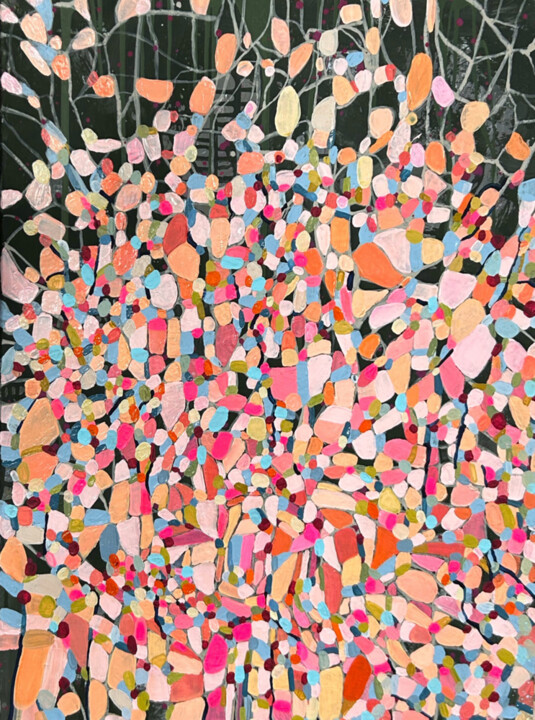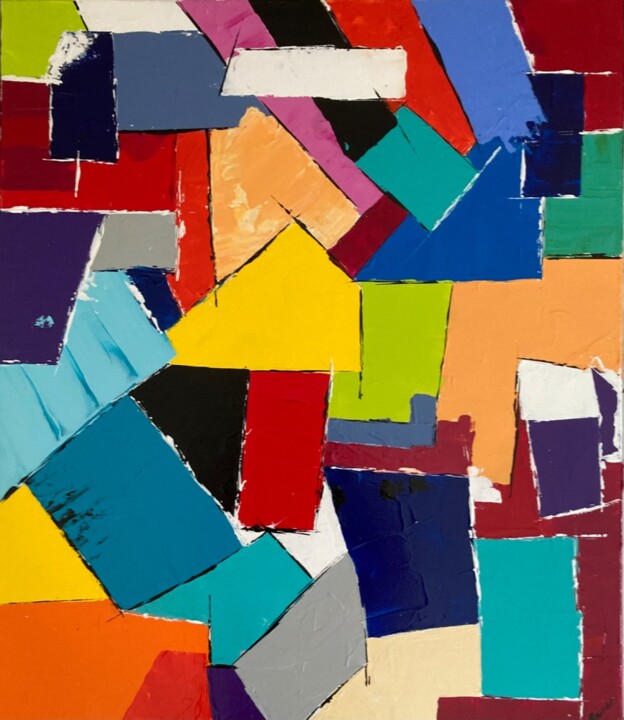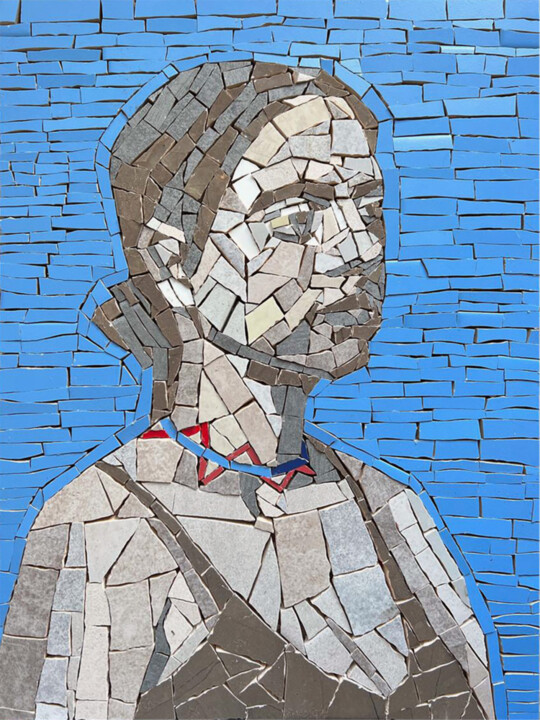 LARGE PEACH ABSTRACT MOSAIC PAINTING (2023)Painting by Julia Brinkfrau
LARGE PEACH ABSTRACT MOSAIC PAINTING (2023)Painting by Julia Brinkfrau
The history of Mosaic
The early mosaics (from the Sumerians to the Romans): The history of mosaic art begins with the earliest civilizations, such as the Sumerians, Egyptians, and the people of the Minoan-Mycenaean region, who used this technique to adorn their buildings, sarcophagi, and floors. This practice continued with the Greeks and Romans, where mosaic flooring gained prominence. Taking a brief detour into the Roman world, mosaic art, gradually becoming independent of Greek models, was initially considered a luxury item. Its slow spread primarily involved thermal baths and public spaces. In more common settings, more economical solutions were chosen, far removed from the costly, polychromatic mosaics that typically depicted various scenes of life and hunting. Nonetheless, the depicted subjects often reflected the environment in which the mosaic was located, with mythological scenes adorning temples, marine motifs in baths, athletes in gymnasiums, and so on... As for wall mosaics, they emerged towards the end of the Roman Republic, with some of the most famous examples found in the Grottoes of the Muses, as well as in Pompeii and Herculaneum. The popularity, diffusion, style, and techniques of mosaic art varied throughout the Roman era, showcasing tendencies toward both figurative and abstract representations.
The Islamic World: Islamic art originated around the second half of the 7th century and subsequently influenced the Christian world, as seen, for example, in Sicily and Spain. Mosaics began to spread in all these places from the 8th century, and they must be understood within their geometric and floral patterns, designed to adhere to a prevailing rejection of realistic forms, aimed at discouraging idolatry. Examples of such mosaics can be found in the Dome of the Rock in Jerusalem, the Great Mosque of the Umayyads in Damascus, as well as in the ruins of Hisham's Palace in Jericho.
 MOSAIC (2023)Digital Arts by Thomas Thomopoulos
MOSAIC (2023)Digital Arts by Thomas Thomopoulos
The Byzantine Era: We can summarize this period by referring to the mosaic art in some specific places and cities, mainly identified as Ravenna (Italy), the Veneto region (northern Italy), Constantinople (modern-day Istanbul), Rome, and Milan.
Ravenna: The places of worship in Ravenna began to be adorned with mosaics starting in the 5th century, when the Italian city became the new capital of the Western Roman Empire. The most significant examples of mosaic decorations can be seen in the Mausoleum of Galla Placida, the Basilica of Sant'Apollinare Nuovo, San Vitale, and Sant'Apollinare in Classe. It is important to highlight that the mosaics in Ravenna, like those in Constantinople, another imperial city, were generally made of glass and gold tesserae, featuring stationary figures that seem to float against the background.
Venetian Area: An example of Venetian mosaic art can be found in the Patriarchal Basilica of Santa Maria Assunta, where the 4th-century Early Christian floor depicting scenes from the Old Testament illustrates a naturalistic style still influenced by Hellenistic traditions, which had already evolved beyond in Rome.
Rome and Milan: What has been mentioned can be observed in the late antique and Byzantine mosaic decorations of the Mausoleum of Santa Costanza, the Basilica of Santa Pudenziana, and the Basilica of Saints Cosmas and Damian in Rome. In Milan, there are exceptional mosaics in the apse of San Vittore in Ciel d'Oro, the Basilica of Sant'Ambrogio, and the Basilica of San Lorenzo.
 ABSTRACT MOSAIC (2020)Painting by Petr Johan Marek
ABSTRACT MOSAIC (2020)Painting by Petr Johan Marek
The Medieval, Renaissance, and Baroque Periods: In the Romanesque art, mosaics were largely set aside due to economic reasons, with a preference for frescoes or the use of inexpensive glazed wax tiles. However, during the Renaissance, mosaics regained popularity, albeit as a form of virtuosity rather than an autonomous creative medium. In the context of the Baroque era, the proliferation of Mannerism led to the revival of a mosaic technique inspired by Imperial Rome, using pebbles and natural elements, sometimes integrated with paintings and sculptures. Mosaic art became subservient to architecture and painting.
 MOSAÏQUE (2021)Painting by Catherine Reiner Steinfels
MOSAÏQUE (2021)Painting by Catherine Reiner Steinfels
Mosaic in the 19th and 20th Centuries: While Neoclassicism almost forgot about mosaics, they experienced a resurgence with Romanticism, alongside stained glass and techniques of wood carving and marquetry. Furthermore, in the 19th century, there was a shift towards faster and more cost-effective techniques. In the following century, eclectic and highly personal interpretations of mosaic art gained prominence, exemplified by well-known artists such as Antoni Gaudí, Gustav Klimt, Gino Severini, Achille Funi, and Massimo Campigli.
Contemporary Times: Contemporary mosaic art, similar to the 20th century, is characterized by individual approaches to the technique. It has been shaped by the work of artists like Oskar Kokoschka, Enzo Cucchi, Aldo Mondino, Ezio Frigerio, Niki de Saint Phalle, and many others. The story of contemporary mosaic art continues today through the work of three artists on Artmajeur...
 PORTRAIT OF HALYNA, THE ARTIST (2023)Sculpture by Andrii Davydenko
PORTRAIT OF HALYNA, THE ARTIST (2023)Sculpture by Andrii Davydenko
PORTRAIT OF HALYNA, THE ARTIST by Andrii Davydenko
The works of the artists on Artmajeur that I have chosen demonstrate various contemporary approaches to mosaic art, some more faithful than others to the original execution of the genre. Let's begin by stating that mosaic art is a polychromatic technique achieved by using fragments of different materials, traditionally pebbles, ceramics, marble, sandstone squares, and glass, often decorated with gold and precious stones. As for the supports, they are generally made of tuff, wood, or glass, and the creation involves the execution of a preparatory design onto which the tesserae (mosaic tiles) are attached. Alternatively, the tesserae can be attached in reverse on a temporary support, which will later be replaced by the final one. Turning to Davydenko's work, it appears to adhere to the materials and execution method described above, which, in this specific context, has been used to capture the likeness of an artist colleague. Andrii Davydenko, a Ukrainian painter born in 2001, frequently employs the mosaic technique, as he has stated that the goal of his art is to explore various subjects through different means, often involving the study of architectural elements in his country.
 MECCASET (2023)Sculpture by Xaro
MECCASET (2023)Sculpture by Xaro
MECCASET by Xaro
This artwork is composed of metal, acrylics, ink, and wood, evoking, in its original concept, the typical interlocking of mosaic fragments, often seen as components of paintings, architecture, and, in this specific case, a sculpture. What are some ancient examples of what has just been illustrated? To find remote mosaic sculptures, we can refer to the Aztec civilization, which between the 13th and 16th centuries used to decorate masks and ritual objects with turquoise mosaics. Moving closer to our times, well-known examples include mosaic sculptures by Antoni Gaudí, Lucio Fontana, Mirko Basaldella, Athos Ongaro, Alessandro Mendini, and many others. Returning to the Artmajeur artist XaRo, closely tied to the world of graphic design, he creates works that have both decorative and conceptual elements, materialized in the form of obsolete toys designed to evoke childhood memories. Additionally, we can interpret other works in XaRo's production as further modes of interpretation and modernization of the mosaic technique, recognizable in the simple juxtaposition and assembly of parts, which, when combined to form a single image, are created through digital art.
 MOSAIC GIRL 002 (2023)Digital Arts by Saro
MOSAIC GIRL 002 (2023)Digital Arts by Saro
MOSAIC GIRL 002 by Saro
It is essential to look at this artwork in light of the artist's words: "For over twenty years, I have accumulated a phenomenal amount of snapshots of stickers, graffiti, and tags found here and there in the streets. Today, I use these works, collected mainly in European and American cities or simply in the neighborhoods of Lausanne, to create mosaics depicting enchanting women. Through this work, I intend to celebrate female beauty, viewing it as a celebration of all the facets that make women beautiful and strong." It can now be said that the mosaic technique has evolved, expanding through the inclusion of digital art, where, instead of selecting and painting the tiles, precise photographs are taken. These photos are later chosen to create a unified vision, ready to tell us a premeditated story, no longer fragmented. Speaking of Vincent Ackermann, a Swiss artist born in 1983, he draws inspiration from hip-hop culture and its graphic universe, which he initially approached through painting. Only later did he realize his aptitude for photography, which he combines with digital art, primarily used to create collages of elegant women.


 Olimpia Gaia Martinelli
Olimpia Gaia Martinelli











